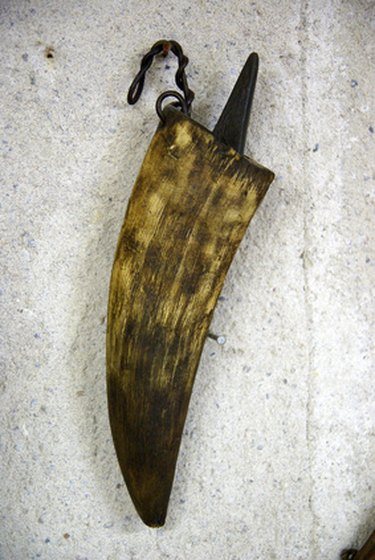
The use of cow horns as material for crafted items has been going on since the middle ages. Cow horns are often a milky color with patches of black, white or brown and are usually quite thick. They are made of three parts: keratin, bone and soft tissue. When making items from cow horn, the individual will first remove the bone inside, leaving the hollow keratin structure.
Choice of Horn
Video of the Day
Cow horn can be purchased either pre-prepared, i.e., boiled and stripped of its inner content with only the outer keratin shell left behind, or as a raw material so the buyer can prepare it. Sometimes the pre-prepared cow horns are also cleaned and sanded down for a smooth exterior and interior.
Video of the Day
Preparation
For those who wish to prepare their cow horn themselves, there are a few methods to consider. The preparation times can range from a couple of days to a few months. The quickest methods involve manually scooping out the soft core of the cow horn or soaking it in boiling water. Other methods include outdoor drying or using flesh-eating insects such as maggots or meal worms. Both methods take at least a week. The longest method involves soaking the horn in water for a couple of months. This is considered to be the best method of preparation--especially if time is not an issue.
Cleaning Cow Horns
If the soft tissue is left inside for longer than necessary, it will start to decay, and that will have adverse effects on the horn itself. It is, therefore, important to make sure that all of the soft tissue is removed from the horn. Any long-reaching household cleaning tool, such as a long-handled brush, should effectively clean most of the inside.
Finishing Touches
The desired final look of the horn can be created by sawing or carving off sections that won't be needed, sanding down the inside and outside of the horn to make it more aesthetically pleasing and pleasant to touch or even heating it up to such a high temperature that it can be shaped into alternate designs. If the heat option is chosen, the best methods are boiling the horn in water or using a propane torch.
Making Items
Once the cow horn is a hollow shell of keratin, it can be made into a number of different items. Some items frequently made from cow horn are containers, cups, pipes and musical instruments. It is also possible to make combs, spoons and ink containers from the resulting material.